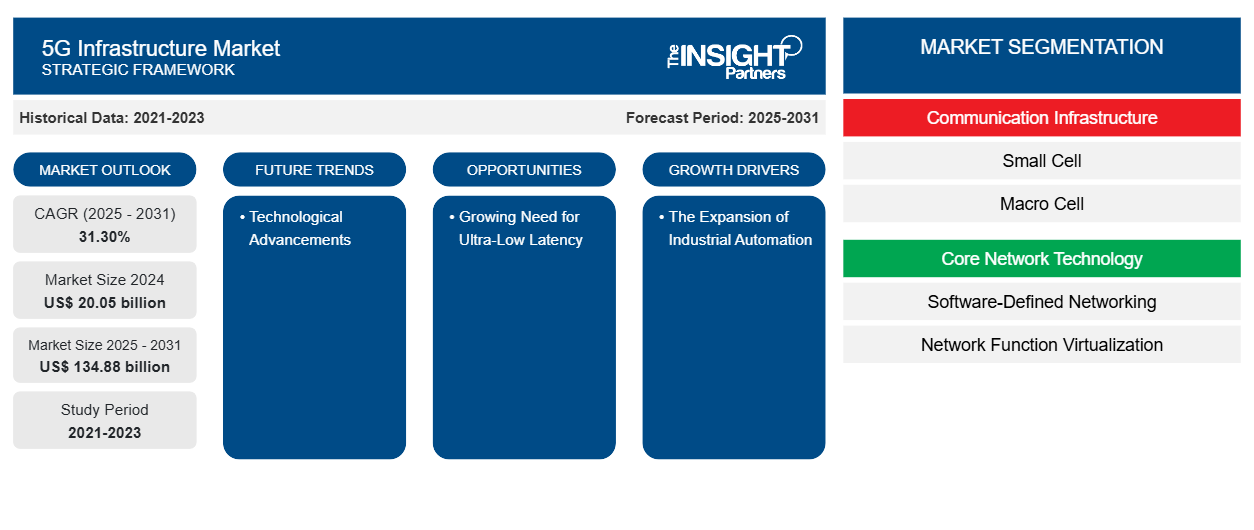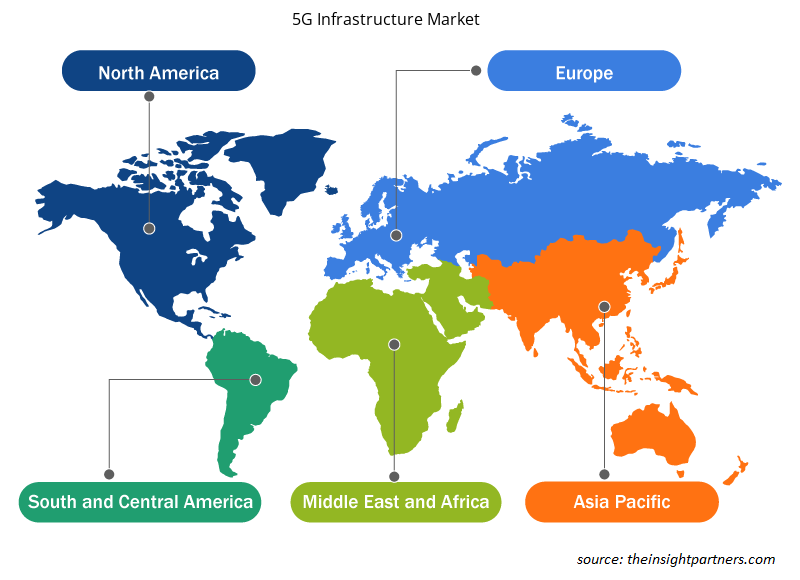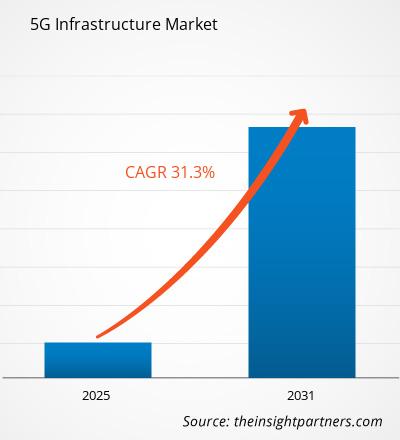The 5G Infrastructure Market size is projected to reach US$ 134.88 billion by 2031 from US$ 15.27 billion in 2023. The market is expected to register a CAGR of 31.30% in 2023–2031. The expansion of industrial automation and a new wave of IoT applications are likely to fuel market growth.
5G Infrastructure Market Analysis
The increasing amount of smart city initiatives globally is boosting the need for 5G due to its ability to deliver quicker communication infrastructure, analytics, IoT, and automation for environmental conservation, enhance traffic flow, and ensure public safety. Additionally, the increasing amount of interconnected IoT devices is driving the expansion of the 5G infrastructure market. Moreover, the increasing industrial automation is boosting the need for 5G. 5G technology offers lower latency, greater reliability, and faster speeds that aid emerging technologies and their inventive methods in smart factories, leading to a chance for the expansion of the 5G infrastructure market. Furthermore, increased government investment in 5G infrastructure across various nations will further drive market expansion in the projected timeframe.
5G Infrastructure Market Overview
The 5G infrastructure is a network of large and small cell base stations with the necessary capabilities for the operation of the fifth-generation cellular network technology standard. The availability of 5G infrastructure enables quick data processing for big data streams, which is advantageous for applications such as augmented reality, semi-autonomous vehicles, and Internet of Things devices. Two categories of 5G network infrastructure exist: non-standalone (NSA) setups, which utilize certain 4G LTE equipment, and standalone 5G infrastructures, which feature their cloud-native network core connecting to 5G New Radio (NR) technologies.
Customize This Report To Suit Your Requirement
You will get customization on any report - free of charge - including parts of this report, or country-level analysis, Excel Data pack, as well as avail great offers and discounts for start-ups & universities
5G Infrastructure Market: Strategic Insights

- Get Top Key Market Trends of this report.This FREE sample will include data analysis, ranging from market trends to estimates and forecasts.
Customize This Report To Suit Your Requirement
You will get customization on any report - free of charge - including parts of this report, or country-level analysis, Excel Data pack, as well as avail great offers and discounts for start-ups & universities
5G Infrastructure Market: Strategic Insights

- Get Top Key Market Trends of this report.This FREE sample will include data analysis, ranging from market trends to estimates and forecasts.
5G Infrastructure Market Drivers and Opportunities
The Expansion of Industrial Automation to Fuel the Market
Automation is becoming more sought-after in different industries across the globe. Fast wireless communication is crucial for automation and interconnectivity, acting as a bridge between machines, sensors, and users for smooth and expandable connectivity. Moreover, it connects automated guided vehicles (AGVS), robotics, drones, and the Internet of Things (IoT). Additionally, increased factory automation boosts productivity and product quality while reducing production costs. Additionally, industrial automation has become highly sought after in industries such as automotive, manufacturing, and others due to its ability to safeguard consistent and high-quality results in production. Automation is becoming more sought-after in different industries across the globe. Fast wireless communication is crucial for automation and interconnectivity, acting as a bridge between machines, sensors, and users for smooth and expandable connectivity.
New Wave of IoT Applications to Support Market Growth
The emergence of 5G technology is leading to significant developments in the Internet of Things (IoT). It serves as a robust facilitator for a new wave of applications that will utilize edge computing to enhance the effectiveness and efficiency of IoT. 5G's impact can be seen as the interplay between two persistent trends: the growth of highly dependable, high-capacity communications and the widespread distribution of computing power across networks. This computational power extends beyond the network to include smarter and more powerful endpoint devices. As telecommunications companies redesign their networks for 5G, a more dynamic and potent computational environment is taking shape, which will drive the adoption of IoT applications and services across various industries. Anticipated benefits of 5G include the facilitation of new applications in areas such as remote monitoring, visual inspection, autonomous operations in large remote settings like mines, and connectivity for vehicles, among others. The expanding array of computing options necessitates a more adaptable approach to developing and deploying applications and AI models that can efficiently utilize the most cost-effective computing resources available. Furthermore, these AI models can now operate on edge devices connected to the network edge, leading to more secure and efficient data processing.
Growing Need for Ultra-Low Latency– An Opportunity in the Market
The adoption of cutting-edge expertise, such as the Internet of Things (IoT), connected devices, Artificial Intelligence, Augmented & Virtual Reality, and others, is on the rise. However, many industries face challenges in fully leveraging these technologies due to high latency. 5G technology offers ultra-low latency capabilities, enhancing user experience and driving demand in mission-critical applications. Notably, in telemedicine, low latency enables real-time access to critical data, paving the way for future remote robotic surgeries. In manufacturing, 5G can optimize connected robotic systems, improving the efficiency of Industrial IoT devices and machines. Additionally, 5G is poised to enhance assisted driving and transport services through real-time data alerts, improving safety. Furthermore, its low latency is set to revolutionize virtual and augmented reality applications, offering users a highly immersive experience and driving the demand for 5G infrastructure.
5G Infrastructure Market Report Segmentation Analysis
Key segments that contributed to the derivation of the 5G Infrastructure Market analysis are communication infrastructure, core network technology, operational frequency, network architecture, and end user.
- Based on communication infrastructure, the market is segmented into small cells and macro cells. The small cell segment held a significant market share in 2023.
- In terms of core network technology, the market is segmented into software-defined networking (SDN) and network function virtualization (NFV). The software-defined networking (SDN) segment held a substantial share of the market in 2023.
- Based on operational frequency, the market is segmented into Sub 6 GHz and Above 6 GHz. The Sub 6 GHz segment held a substantial share of the market in 2023.
- In terms of network architecture, the market is segmented into standalone and non-standalone. The standalone segment held a substantial share of the market in 2023.
- Based on end user, the market is segmented into residential, commercial, government, and industrial. The residential segment held a substantial share of the market in 2023.
5G Infrastructure Market Share Analysis by Geography
The geographic scope of the 5G Infrastructure Market report is mainly divided into five regions: North America, Asia Pacific, Europe, Middle East & Africa, and South America/South & Central America.
Governments in various Asia Pacific countries, including China and India, are actively improving their digital and network infrastructure in response to the increasing internet usage. The swift implementation of 5G, driven by ongoing digital advancements, is expected to stimulate market growth in the region. According to the 2022 GSMA report, 14 countries already have commercially accessible 5G networks. Vietnam and India are projected to experience rapid 5G network adoption in the near future, consequently driving the demand for 5G infrastructure.
5G Infrastructure Market Regional Insights
The regional trends and factors influencing the 5G Infrastructure Market throughout the forecast period have been thoroughly explained by the analysts at Insight Partners. This section also discusses 5G Infrastructure Market segments and geography across North America, Europe, Asia Pacific, Middle East and Africa, and South and Central America.

- Get the Regional Specific Data for 5G Infrastructure Market
5G Infrastructure Market Report Scope
| Report Attribute | Details |
|---|---|
| Market size in 2024 | US$ 20.05 billion |
| Market Size by 2031 | US$ 134.88 billion |
| Global CAGR (2025 - 2031) | 31.30% |
| Historical Data | 2021-2023 |
| Forecast period | 2025-2031 |
| Segments Covered |
By Communication Infrastructure
|
| Regions and Countries Covered | North America
|
| Market leaders and key company profiles |
5G Infrastructure Market Players Density: Understanding Its Impact on Business Dynamics
The 5G Infrastructure Market market is growing rapidly, driven by increasing end-user demand due to factors such as evolving consumer preferences, technological advancements, and greater awareness of the product's benefits. As demand rises, businesses are expanding their offerings, innovating to meet consumer needs, and capitalizing on emerging trends, which further fuels market growth.
Market players density refers to the distribution of firms or companies operating within a particular market or industry. It indicates how many competitors (market players) are present in a given market space relative to its size or total market value.
Major Companies operating in the 5G Infrastructure Market are:
- Cisco Systems, Inc.
- Huawei Technologies Co., Ltd.
- Intel Corporation
- MediaTek Inc.
- NEC Corporation
- Affirmed Networks Inc.
Disclaimer: The companies listed above are not ranked in any particular order.

- Get the 5G Infrastructure Market top key players overview
5G Infrastructure Market News and Recent Developments
The 5G Infrastructure Market is evaluated by gathering qualitative and quantitative data post primary and secondary research, which includes important corporate publications, association data, and databases. The following is a list of developments in the market:
- The 5G Smart Factory Forum was held today at the Huawei European Supply Center (HESC) in Budapest. At the forum, Huawei stated that 5G-powered innovative solutions, including self-driving vehicles, AI-driven quality control, and AR-assisted remote maintenance, will serve as the typical applications and basic capabilities of future smart factories.
(Source: Huawei Technologies Co., Ltd., Company News, 2023)
- At the 5G Core Summit hosted by Informa Tech, George Gao, President of Huawei Cloud Core Network Product Line, launched the 5.5G Intelligent Core Network solution. The solution is equipped with native intelligence, making it powerful enough to implement service intelligence, network intelligence, and O&M intelligence so as to empower more new businesses and light up an intelligent world.
(Source: Huawei Technologies Co., Ltd., Company News, 2023)
- The technology company Siemens is launching a private infrastructure developed in-house for the 5G mobile communications standard. The solution enables industrial companies to build their own local 5G networks that will provide optimal support for automation applications. "By building their own 5G networks, industrial companies are launching the next stage of connected production," says Axel Lorenz, CEO of Process Automation at Siemens. "5G is crucial for applications like mobile robots, autonomous logistics, and driverless transport systems in factories. Siemens' private 5G infrastructure also gives users sole control over the data in their 5G network at all times, and they can custom-configure the network for their applications."
(Source: Siemens, Press Release, 2023)
5G Infrastructure Market Report Coverage and Deliverables
The “5G Infrastructure Market Size and Forecast (2021–2031)” report provides a detailed analysis of the market covering below areas:
- 5G Infrastructure Market size and forecast at global, regional, and country levels for all the key market segments covered under the scope
- Market dynamics such as drivers, restraints, and key opportunities
- 5G Infrastructure Market Trends
- Detailed PEST/Porter’s Five Forces and SWOT analysis
- 5G Infrastructure Market analysis covering key market trends, major players, regulations, and recent market developments
- 5G Infrastructure industry landscape and competition analysis covering market concentration, heat map analysis, prominent players, and recent developments
- Detailed company profiles
- Historical Analysis (2 Years), Base Year, Forecast (7 Years) with CAGR
- PEST and SWOT Analysis
- Market Size Value / Volume - Global, Regional, Country
- Industry and Competitive Landscape
- Excel Dataset
Testimonials
Reason to Buy
- Informed Decision-Making
- Understanding Market Dynamics
- Competitive Analysis
- Identifying Emerging Markets
- Customer Insights
- Market Forecasts
- Risk Mitigation
- Boosting Operational Efficiency
- Strategic Planning
- Investment Justification
- Tracking Industry Innovations
- Aligning with Regulatory Trends
Yes! We provide a free sample of the report, which includes Report Scope (Table of Contents), report structure, and selected insights to help you assess the value of the full report. Please click on the "Download Sample" button or contact us to receive your copy.
Absolutely — analyst assistance is part of the package. You can connect with our analyst post-purchase to clarify report insights, methodology or discuss how the findings apply to your business needs.
Once your order is successfully placed, you will receive a confirmation email along with your invoice.
• For published reports: You’ll receive access to the report within 4–6 working hours via a secured email sent to your email.
• For upcoming reports: Your order will be recorded as a pre-booking. Our team will share the estimated release date and keep you informed of any updates. As soon as the report is published, it will be delivered to your registered email.
We offer customization options to align the report with your specific objectives. Whether you need deeper insights into a particular region, industry segment, competitor analysis, or data cut, our research team can tailor the report accordingly. Please share your requirements with us, and we’ll be happy to provide a customized proposal or scope.
The report is available in either PDF format or as an Excel dataset, depending on the license you choose.
The PDF version provides the full analysis and visuals in a ready-to-read format. The Excel dataset includes all underlying data tables for easy manipulation and further analysis.
Please review the license options at checkout or contact us to confirm which formats are included with your purchase.
Our payment process is fully secure and PCI-DSS compliant.
We use trusted and encrypted payment gateways to ensure that all transactions are protected with industry-standard SSL encryption. Your payment details are never stored on our servers and are handled securely by certified third-party processors.
You can make your purchase with confidence, knowing your personal and financial information is safe with us.
Yes, we do offer special pricing for bulk purchases.
If you're interested in purchasing multiple reports, we’re happy to provide a customized bundle offer or volume-based discount tailored to your needs. Please contact our sales team with the list of reports you’re considering, and we’ll share a personalized quote.
Yes, absolutely.
Our team is available to help you make an informed decision. Whether you have questions about the report’s scope, methodology, customization options, or which license suits you best, we’re here to assist. Please reach out to us at sales@theinsightpartners.com, and one of our representatives will get in touch promptly.
Yes, a billing invoice will be automatically generated and sent to your registered email upon successful completion of your purchase.
If you need the invoice in a specific format or require additional details (such as company name, GST, or VAT information), feel free to contact us, and we’ll be happy to assist.
Yes, certainly.
If you encounter any difficulties accessing or receiving your report, our support team is ready to assist you. Simply reach out to us via email or live chat with your order information, and we’ll ensure the issue is resolved quickly so you can access your report without interruption.





















 Get Free Sample For
Get Free Sample For